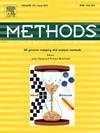用于乳腺癌细胞检测的超灵敏石墨烯微带集成太赫兹生物传感器
IF 4.3
3区 生物学
Q1 BIOCHEMICAL RESEARCH METHODS
引用次数: 0
摘要
近几十年来,随着癌症发病率的上升,早期和快速诊断以及对癌细胞的精确描述比以往任何时候都更加重要。本文介绍了一种在太赫兹波段工作的新型超表面辅助生物传感器,用于非侵入性和快速检测乳腺癌细胞。该生物传感器采用石墨烯微带增强太赫兹波相互作用,提高了生物传感器的灵敏度和整体性能。当用于癌细胞传感时,生物传感器在2.0012 THz、2.8734 THz和3.2948 THz处表现出三个吸收峰,分别为99.18%、89.55%和99.93%。该生物传感器的最大频移为49 GHz,最大理论灵敏度为3.5 THz/RIU(折射率单位),品质系数为6.81 RIU−1。此外,该传感器的检测限为0.26 RIU,分辨率为0.91太赫兹。所提出的生物传感器检测微小折射率变化(低至0.26 RIU)的能力增加了传感器的多功能性,使其能够在各种临床和实验室环境中使用。鉴于这些特点和性能,所提出的生物传感器是非侵入性癌症诊断的巨大希望,在便携式和小型化平台上提供超高灵敏度。本文章由计算机程序翻译,如有差异,请以英文原文为准。
Ultra-sensitive graphene micro-ribbon integrated THz biosensor for breast cancer cell detection
In recent decades, the rising incidence of cancer has made early and rapid diagnosis, along with precise characterization of cancer cells, more crucial than ever. The paper presents a novel metasurface-assisted biosensor operating in the THz regime, designed for non-invasive and rapid detection of breast cancer cells. The proposed biosensor incorporates graphene micro-ribbons to enhance THz wave interaction, boosting the biosensor’s sensitivity and overall performance. When used for cancer cell sensing, the biosensor demonstrates three absorption peaks at 2.0012 THz, 2.8734 THz, and 3.2948 THz with the absorption of 99.18 %, 89.55 %, and 99.93 %, respectively. The biosensor achieves a maximum frequency shift of 49 GHz, a maximum theoretical sensitivity of 3.5 THz/RIU (Refractive Index Unit), and a figure of merit of 6.81 RIU−1. Additionally, the sensor offers an excellent detection limit of 0.26 RIU and a resolution of 0.91 THz. The ability of the proposed biosensor to detect small refractive index changes (as low as 0.26 RIU) adds to the sensor’s versatility, allowing it to be used in a wide variety of clinical and laboratory settings. Given these features and performance, the proposed biosensor holds great promise for non-invasive cancer diagnostics, offering ultra-high sensitivity in a portable and miniaturized platform.
求助全文
通过发布文献求助,成功后即可免费获取论文全文。
去求助
来源期刊

Methods
生物-生化研究方法
CiteScore
9.80
自引率
2.10%
发文量
222
审稿时长
11.3 weeks
期刊介绍:
Methods focuses on rapidly developing techniques in the experimental biological and medical sciences.
Each topical issue, organized by a guest editor who is an expert in the area covered, consists solely of invited quality articles by specialist authors, many of them reviews. Issues are devoted to specific technical approaches with emphasis on clear detailed descriptions of protocols that allow them to be reproduced easily. The background information provided enables researchers to understand the principles underlying the methods; other helpful sections include comparisons of alternative methods giving the advantages and disadvantages of particular methods, guidance on avoiding potential pitfalls, and suggestions for troubleshooting.
 求助内容:
求助内容: 应助结果提醒方式:
应助结果提醒方式:


